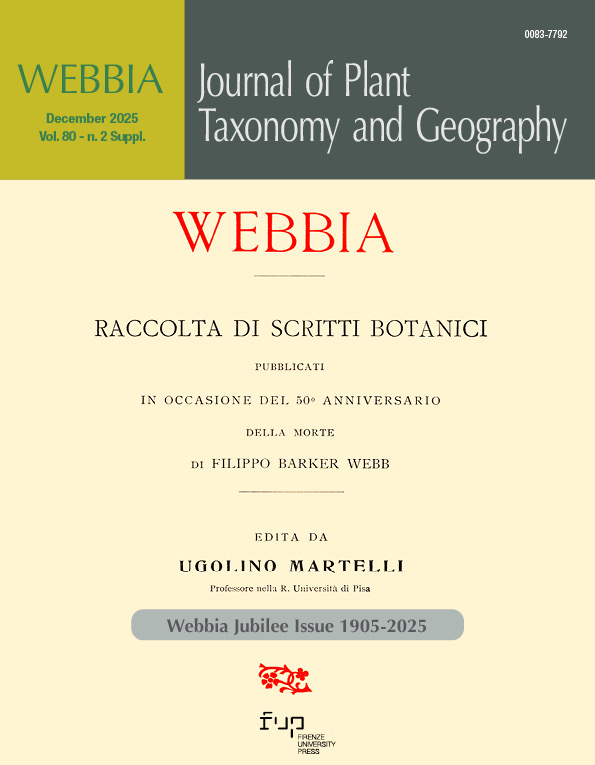Published 2025-11-17
Keywords
- Ethiopia,
- extinction risk,
- hotspot,
- Kenya,
- phytogeography
- Somalia,
- subsection,
- taxonomy ...More
How to Cite
Copyright (c) 2025 Ellie Defty, Sebastian Hatt, Mats Thulin, Hanny Lidetu, Iain Darbyshire

This work is licensed under a Creative Commons Attribution 4.0 International License.
Abstract
The recently recognised Quadrispina clade within Barleria sect. Prionitis Nees (Acanthaceae) represents a taxonomically challenging group endemic to the Horn of Africa biodiversity hotspot. This study presents a comprehensive taxonomic revision of the complex, driven by morphological assessment and morphometric analyses. We recognise seven species in the complex in total, including four new species to science that had previously been included within B. quadrispina, namely B. filtuensis, B. mudugensis, B. puberulifolia and B. sebsebei. In addition, we recognise four subspecies within B. quadrispina, namely subsp. quadrispina, subsp. glaucobracteata, subsp. waggana and the newly described subsp. kenyana. Conservation assessments based on IUCN Red List categories and criteria indicate that B. filtuensis, B. mudugensis, B. puberulifolia, B. sebsebei and B. quadrispina subsp. glaucobraceata are range-restricted and potentially threatened by habitat degradation, hence they are preliminarily assessed as threatened under criterion B, whilst B. quadrispina subsp. kenyana remains Data Deficient.
References
- Bachman S, Moat J, Hill AW, de la Torre J, Scott B. 2011. Supporting red list threat assessments with GeoCAT: Geospatial conservation assessment tool. ZooKeys. 150: 117–126. https://doi.org/10.3897/zookeys.150.2109
- CEPF. 2025. Critical Ecosystem Partnership Fund. Horn of Africa Biodiversity Hotspot, [accessed 2025 Feb 25]. Available from: https://www.cepf.net/our-work/biodiversity-hotspots/horn-africa
- Comito R, Darbyshire I, Kiel C, McDade L, Fisher AE. 2022. A RADseq phylogeny of Barleria (Acanthaceae) resolves fine-scale relationships. Molecular Phylogenetics and Evolution. 169: 107428. https://doi.org/10.1016/j.ympev.2022.107428
- Darbyshire I, Vollesen K, Ensermu K. 2010. Acanthaceae (part II). In: Beentje H. (Ed.), Flora of Tropical East Africa. London: Royal Botanic Gardens, Kew.
- Darbyshire I, Fisher AE, Kiel CA, McDade LA. 2019. Phylogenetic relationships among species of Barleria (Acanthaceae, Lamiales): Molecular data reveal complex patterns of morphological evolution and support a revised classification. Taxon. 68: 92–111. https://doi.org/10.1002/tax.12029
- Darbyshire I, Roberts A. 2023. Barleria negeleensis. IUCN Red List Threat Species. 2023:e.T219403827A219405363. https://doi.org/10.2305/IUCN.UK.2023-1.RLTS.T219403827A219405363.en
- Darbyshire I, Roberts A, Sebsebe D. 2023. Barleria ferox. IUCN Red List Threat Species. 2023:e.T219403659A219405343. https://doi.org/10.2305/IUCN.UK.2023-1.RLTS.T219403659A219405343.en
- Defty E, Darbyshire I. 2024. New taxa of Barleria sect. Prionitis (Acanthaceae) from the Horn of Africa biodiversity hotspot in Somalia. Webbia. 79:19–29. https://doi.org/10.36253/jopt-15729
- Ensermu K. 2006. Acanthaceae. In: Hedberg I, Ensermu K, Edwards S, Sebsebe D, Persson E. (Eds.), Flora of Ethiopia and Eritrea. Vol. 5. Addis Ababa: The National Herbarium, Addis Ababa University; Uppsala: The Department of Systematic Botany, Uppsala University. Pp. 345–495.
- Ensermu K, Darbyshire I. 2018. Six new species of Barleria L. (Acanthaceae) from northeast tropical Africa. Kew Bulletin 73(1):1. https://doi.org/10.1007/s12225-017-9725-2
- Friis I, Sebsebe D, van Breugel P. 2010. Atlas of the Potential Vegetation of Ethiopia. Biologiske Skrifter. 58: 1–307.
- Friis I, van Breugel P, Weber O, Sebsebe D. 2022. The Western Woodlands of Ethiopia - A study of the woody vegetation and flora between the Ethiopian Highlands and the lowlands of the Nile Valley in the Sudan and South Sudan. Scientia Danica. Series B, Biologica 9: 1–521.
- Hanny L, Hoban G, Lockyear O, Belcher A, Svahnström VJ, Darbyshire I. 2024. Additions to and revisions of the endemic and near-endemic Acanthaceae of Ethiopia. Webbia. 79: 201–225. https://doi.org/10.36253/jopt-16074
- Hedberg I, Friis I, Persson E. (Eds.) 2009. Flora of Ethiopia and Eritrea. Vol. 8: General Part and Index to Vols 1–7. Addis Ababa: The National Herbarium, Addis Ababa University; Uppsala: The Department of Systematic Botany, Uppsala University.
- Hedrén M. 2006a. Barleria. In: Thulin M. (Ed.), Flora of Somalia. Vol. 3. London: Royal Botanic Gardens, Kew. Pp. 427–442.
- Hedrén M. 2006b. New species and combinations in Acanthaceae from Somalia. Willdenowia. 36: 751–759. https://doi.org/10.3372/wi.36.36210
- IUCN. 2012. IUCN Red List Categories and Criteria: Version 3.1. Second edition. Gland & Cambridge: IUCN Species Survival Commission. https://portals.iucn.org/library/node/10315
- IUCN. 2024. Guidelines for the application of IUCN Red List of Ecosystems Categories and Criteria, Version 16. Prepared by the Standards and Petitions Committee, [accessed 2025 May 01]. https://www.iucnredlist.org/resources/redlistguidelines
- Lindau G. 1896. Contribuzioni alla conoscenza della flora dell’Africa orientale. Acanthaceae somalenses a DD. L. Bricchetti-Robecchi et Dr. Riva in Harrar et in Somalia lectae. Annuario del Reale Istituto Botanico di Roma. 6: 67–83.
- Lovett JC, Friis I. 1996. Patterns of endemism in the woody flora of north-east and east Africa. In: Van der Maesen LJG, van der Burgt XM, van Medenbach de Rooy JM. (Eds.), The Biodiversity of African Plants: Proceedings of the 14th AETFAT Congress 22–27 August 1994, Wageningen, The Netherlands. Dordrecht: Kluwer Academic Publishers. Pp. 582–601.
- Polhill D. 1988. Flora of Tropical East Africa. Index of Collecting Localities. London: Royal Botanic Gardens, Kew.
- R Core Team. 2021. R: A language and environment for statistical computing. R Foundation for Statistical Computing, Vienna, Austria. https://www.R-project.org/
- Rendle RB. 1896. Dr. Donaldson Smith’s Acanthaceae. Journal of Botany 34: 395–398.
- Thulin M. (Ed.) 1993. Flora of Somalia. Vol. 1: Pteridophyta; Gymnospermae; Angiospermae (Annonaceae–Fabaceae). London: Royal Botanic Gardens, Kew.


